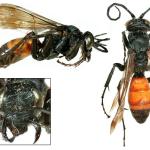This large and readily identifiable pompilid would not be easily overlooked and is now probably extinct in mainland Britain. The species is, however, still recorded in the Channel Islands.
Known in mainland Britain only from two nearby Dorset sites, in 1934 and 1938. A male and a female were taken at the first site (Spooner, 1937) and a single male was taken at the second site, also by G M Spooner (Falk, 1991).
The species occurs in central and northern Europe, and central Asia (Wolf, 1972).
Listed as Endangered (RDB1) in Shirt (1987). Falk (1991) considered the species Extinct (RDB1+).
Day, 1988 is the standard work for identifying British Pompilidae. Wiśniowski, B., 2009 is also useful.
This is a species of sandy heathland in open sunny situations and also coastal dunes (Falk, 1991).
June to September (Day, 1988).
Relatively large spiders are taken by this species. Mainly females of Lycosidae and Gnaphosidae are captured, but other records include Attidae, Clubionidae and Salticidae (Falk, 1991).
Nests are excavated in sandy soils in sunny situations after the prey has been captured and stored nearby. This species apparently shows a strong tendency to re-occupy old burrows, females returning to those from which they emerged (Falk, 1991).
The second male Dorset specimen taken in 1938 was collected from wild angelica flowers (Falk, 1991). Probably other umbellifers are also visited for nectar.
2001


